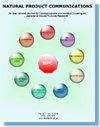Phytochemical Analysis and in vivo Toxicity Study of Extracted Walnut oil in Sprague Dawley Rats
IF 1.4
4区 医学
Q4 CHEMISTRY, MEDICINAL
引用次数: 0
Abstract
Background: Medicinal plants have been the focus of scientific research for many decades worldwide, especially those used in traditional medicine. Objective: To perform the phytochemical analysis of extracted walnut oil (EWO) and its subchronic toxicity profile in Sprague Dawley rats. Methods: In this experimental study, the collected Kurdish walnut was authenticated by an authorized taxonomist and the core was obtained. Then, the walnut oil was extracted using the cold press method and sent for phytochemical analysis using GC-MS. Accordingly, the male Sprague Dawley rats were treated with varying doses of the EWO for four consecutive weeks, and animals were checked daily for abnormality and toxicity behaviours while they were weighed each week. At the end of the study, animals were sacrificed under deep anaesthesia, blood samples and organs were collected, and various hematological and biochemical tests were performed together with histopathological analysis. Results: GC-MS analysis showed that EWO contained 49 compounds, some critical in biomedical fields. The body weight of all treated animals was increased significantly. No significant changes were seen for hematological tests except platelets, which decreased in all treated groups (p = 0.015) compared to the control group. At the same time, AST and chloride levels were decreased (p = 0.002 and p = 0.012, respectively), while total protein and calcium were increased (p = 0.004 and p = 0.033, respectively). Simultaneously, histopathological analysis showed no severe lesions in the brain, moderate lesions in the liver and mild, moderate and severe lesions in the kidneys. Conclusions: EWO is rich in various compounds that contain active medicinal components. The EWO can be used at low doses as it does not affect most hematological and biochemical tests and has no significant toxicity in the vital organs of experimental rats.核桃油提取物的植物化学分析和对 Sprague Dawley 大鼠的体内毒性研究
背景:几十年来,药用植物一直是全球科学研究的重点,尤其是传统医学中使用的药用植物。研究目的对提取的核桃油(EWO)进行植物化学分析,并分析其对 Sprague Dawley 大鼠的亚慢性毒性。方法:在本实验研究中,采集的库尔德核桃由授权的分类学家鉴定并获得核芯。然后,用冷榨方法提取核桃油,并用气相色谱-质谱仪进行植物化学分析。因此,雄性 Sprague Dawley 大鼠连续四周接受不同剂量的 EWO 治疗,每周称重,每天检查动物是否有异常和毒性行为。研究结束时,在深度麻醉下将大鼠处死,收集血液样本和器官,并进行各种血液学和生化测试以及组织病理学分析。研究结果气相色谱-质谱分析表明,EWO 含有 49 种化合物,其中一些对生物医学领域至关重要。所有治疗动物的体重都有明显增加。与对照组相比,除血小板减少(p = 0.015)外,血液学检测未见明显变化。同时,谷草转氨酶和氯化物水平下降(分别为 p = 0.002 和 p = 0.012),而总蛋白和钙增加(分别为 p = 0.004 和 p = 0.033)。同时,组织病理学分析表明,大脑没有严重病变,肝脏有中度病变,肾脏有轻度、中度和重度病变。结论枇杷膏富含多种化合物,其中含有活性药用成分。由于 EWO 不影响大多数血液学和生化测试,对实验大鼠的重要器官也没有明显毒性,因此可以小剂量使用。
本文章由计算机程序翻译,如有差异,请以英文原文为准。
求助全文
约1分钟内获得全文
求助全文
来源期刊

Natural Product Communications
工程技术-食品科技
CiteScore
3.10
自引率
11.10%
发文量
254
审稿时长
2.7 months
期刊介绍:
Natural Product Communications is a peer reviewed, open access journal studying all aspects of natural products, including isolation, characterization, spectroscopic properties, biological activities, synthesis, structure-activity, biotransformation, biosynthesis, tissue culture and fermentation. It covers the full breadth of chemistry, biochemistry, biotechnology, pharmacology, and chemical ecology of natural products.
Natural Product Communications is a peer reviewed, open access journal studying all aspects of natural products, including isolation, characterization, spectroscopic properties, biological activities, synthesis, structure-activity, biotransformation, biosynthesis, tissue culture and fermentation. It covers the full breadth of chemistry, biochemistry, biotechnology, pharmacology, and chemical ecology of natural products.
Natural Product Communications is a peer reviewed, open access journal studying all aspects of natural products, including isolation, characterization, spectroscopic properties, biological activities, synthesis, structure-activity, biotransformation, biosynthesis, tissue culture and fermentation. It covers the full breadth of chemistry, biochemistry, biotechnology, pharmacology, and chemical ecology of natural products.
 求助内容:
求助内容: 应助结果提醒方式:
应助结果提醒方式:


